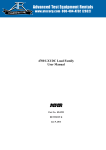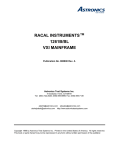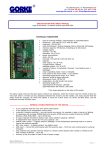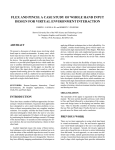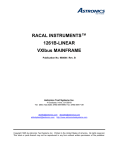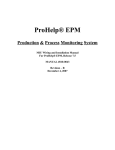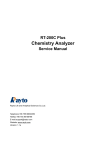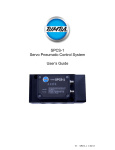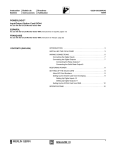Download VXI LOAD OPERATIONS MODELS 81201 & 81210 USER`S MANUAL
Transcript
VXI LOAD OPERATIONS MODELS 81201 & 81210 USER’S MANUAL Part No. 09-0129 REVISION C March 31, 1998 VXI LOAD OPERATIONS MODELS 81201 & 81210 USER’S MANUAL Document History Rev C 2 of 27 ECO 14612 3/31/98 B. H. VXI LOAD OPERATIONS MODELS 81201 & 81210 USER’S MANUAL Proprietary Rights Notice This document and the information that it contains are the property of NH Research, Incorporated. The rights to duplicate or otherwise copy this document, the rights to disclose the document and its information to others, and the right to use the information therein may be acquired only by written permission signed by a duly authorized officer of NH Research, Incorporated. Unauthorized duplication of software and documentation provided with the test workstations violates the copyright protection provided by law. However, backup copies of programs are permitted for archives and recovery from hardware failures. The material in this publication is current as of the release date on the cover page and is subject to change without notice. Any questions concerning the product or any questions or comments concerning this manual should be directed to the NH Research Field Service Department during normal business hours Monday through Friday at (949) 474-3900 or FAX (949) 474-7062 or www.nhresearch.com. POWERTEST and POWERFLEX are trademarks of NH Research, Incorporated. 3 of 27 VXI LOAD OPERATIONS MODELS 81201 & 81210 USER’S MANUAL 4 of 27 VXI LOAD OPERATIONS MODELS 81201 & 81210 USER’S MANUAL TABLE OF CONTENTS 1. INTRODUCTION .............................................................................................................................. 7 2. OPERATIONAL THEORY............................................................................................................... 9 2.1 PROTECTION ....................................................................................................................................... 9 3. VXI LOAD PROGRAMMING SPECIFICATIONS....................................................................... 11 3.1 GENERAL PROGRAMMING STRUCTURE................................................................................................ 13 3.2 READING THE EEPROM.................................................................................................................... 13 4. OPERATING COMMANDS ........................................................................................................... 15 4.1 LOAD RESET...................................................................................................................................... 15 4.2 SET LOAD CURRENT .......................................................................................................................... 15 4.3 SET THE LOAD VOLTAGE ................................................................................................................... 15 4.4 SET THE LOAD OPERATING MODE ...................................................................................................... 16 4.5 MISCELLANEOUS FUNCTIONS ............................................................................................................. 16 5. READING AND METERING ......................................................................................................... 19 5.1 READING LOAD STATUS ..................................................................................................................... 19 5.2 READING THE ANALOG TO DIGITAL CONVERTER (ADC) ..................................................................... 19 5.3 METERING ........................................................................................................................................ 20 6. CALIBRATION ............................................................................................................................... 21 APPENDIX A ....................................................................................................................................... 23 SPECIFICATIONS AND PANEL CONNECTIONS .............................................................................. 23 APPENDIX B ....................................................................................................................................... 27 EEPROM TIMING DIAGRAMS ........................................................................................................... 27 5 of 27 VXI LOAD OPERATIONS MODELS 81201 & 81210 USER’S MANUAL 6 of 27 VXI LOAD OPERATIONS MODELS 81201 & 81210 USER’S MANUAL 1. INTRODUCTION VXIbus electronic loads are designed for low-power output loading of DC power supplies or other devices needing loads with either static or dynamic modes of operation. Each load is a self-contained instrument on a single-slot, C-size VXlbus module making them ideal for applications where size is important. The 81201 and 81210 can be integrated into any VXlbus-based test system, but they are particularly well-suited to the POWERTEST family of automatic power supply test systems from NH Research. Although rated at 50 Watts continuous power, the 81201 and 81210 can be used at considerably higher ratings. As most testing is carried out at substantially lower duty cycles, analog control circuitry is used to continuously monitor internal conditions permitting the load to increase its power handling capability with decreasing duty cycles. Because the monitoring is carried out in real time, the protection circuitry is tripped only if the load is in danger of being damaged. This allows testing for short periods or small duty cycles at power levels in excess of the steady state specifications If higher power is continuously required, two or more loads may be operated in parallel. The 81201 and 81210 offer programmable transient response. Programmable rise times permit the dynamic characteristics of the load to more closely approximate the operational conditions in which the unit under test (UUT) will be expected to function. In applications requiring testing under complex loading profiles, an analog input is provided which allows external control of the load current over the load's full operating ranges. Using an arbitrary waveform generator, virtually any required loading profile can be realized. Frequently, switching power supplies must be turned on into a constant resistance load before testing with a constant current load can begin. The 81201 and 81210 provide a glitch-free transition from one mode to another; the supply under test does not see the load current fall to zero during the mode transition. In the short circuit mode of operation, an SCR in parallel with the shorting relay is used to give fast, low resistance short. It is possible to shift from any mode to any other mode of operation under program control. The loads are fully protected against various fault conditions including overvoltage, reverse voltage, overcurrent, overpower and overtemperature. All calibration and configuration data is stored in an on-board EEPROM, resulting in fast, internal “no pots" calibration of setting and metering parameters. The result is a rugged, highly reliable load that requires minimal maintenance. 7 of 27 VXI LOAD OPERATIONS MODELS 81201 & 81210 USER’S MANUAL 8 of 27 VXI LOAD OPERATIONS MODELS 81201 & 81210 USER’S MANUAL 2. OPERATIONAL THEORY The VXlbus loads use power MOSFETs for the current sinking devices. The control circuits are practically identical for both the 81201 and the 81210 loads. A few resistors and a capacitor in the feedback are the differences (see page 3 of drawing 10-3860). A control voltage is routed to the inverting input of an op-amp U9. The voltage developed across the precision shunt is scaled and routed back into the op-amp. This op-amp drives the gate of the MOSFET and will slew controlling the current until the error goes to zero. The control voltage is programmed by the use of a 12 bit DAC U18. The stable voltage reference for the DAC comes from U13. The DAC reference can come from 2 places, one is the fixed reference, the other is derived from the constant resistance DAC U19. The UUT voltage sensed by op-amp U1 is scaled such that full scale voltage represents 3.75 VDC. This voltage representing the UUT voltage is scaled for any nominal operating voltage selected by DAC U19. Voltage references of both DAC U19 (Constant Resistance) and DAC U18 (Constant Current) can be controlled by op-amp U1. This method of controlling the reference allows the current of the load to be proportional to the UUT voltage (i.e. constant resistance mode). Analog switch U16 controls the selection of references and the mode of operation, Constant Resistance, or Constant Current. U16 also controls slew rates by selecting between RC timing networks. 2.1 Protection Temperature is sensed on the load heat sink by a temperature transducer. The output is scaled by op-amp U15 and is compared to a stabilized reference. The output of the transducer is also scaled by op-amp U8 and summed along with power multiplier U7. Both outputs of the op-amps are ORed through diodes CR8 and CR9. If power is exceeded or the temperature should rise above the preset value the load will be shut down and a status bit will be available to the controller. 9 of 27 VXI LOAD OPERATIONS MODELS 81201 & 81210 USER’S MANUAL 10 of 27 VXI LOAD OPERATIONS MODELS 81201 & 81210 USER’S MANUAL 3. VXI LOAD PROGRAMMING SPECIFICATIONS In general all addresses are offset values from the base load logical address as set be the DIP switch, SW1. SW1: open = 1, closed = 0 NUMBER 1 2 3 4 5 6 7 8 ADDRESS A7 A6 A5 A4 A3 A2 A1 A0 For example, the logical address switch setting for 25(decimal) would look like: 1 2 3 4 5 6 7 8 X X X X X X X X open closed The remaining addresses listed are OFFSET values from the base address. Also, addresses are HEX values, unless specified explicitly. There are four (4) types of VXI load registers that begin at this Base address. Al1 addresses are 16 bits. REGISTER ID (read) OFFSET 00 DEV-TYPE (read) 02 STATUS (read) 04 (write) BIT DEFINITION B0 - B11 : Manufacture ID B12 - B13 : 00 (address space = A16/24) B14 - B15 : 11 (register based) B0 - B11 : Model Code B12 - B15 : 1110 (required memory) B2 : 1 (self test passed) B3 : 1 (self test extended) B14 : MODID* self test extended B15 : A24 active B0 : Reset B1 : Sysfail Inhibit - other bits not used B15 : A24 Enable All device dependent registers begin at address 20 (HEX). There are 5 device write registers and 3 device read registers. 11 of 27 VXI LOAD OPERATIONS MODELS 81201 & 81210 USER’S MANUAL READ ADDRESSES Load Byte OFFSET 20 Over Load Byte Load Byte WRITE ADDRESSES Load Byte 24 26 OFFSET 20 Load Byte 22 Load Byte 24 Load Byte (also all 26 Analog Switches 28 12 of 27 BIT DEFINITION B0 EEPROM DATA IN/OUT (SERIAL) B1 SHORT CIRCUIT (also after an Voltage) B2 Power Limit (1=good, 0=bad) B3 ADC STATUS(1=Converting, 0=done) B4 OVER TEMPERATURE B5 - B7 0 B0 - B7 ADC Lower 8 bits B0 - B3 ADC Upper 4 bits B4 ADC Overrange B5 ADC Polarity BIT DEFINITION B0 EEPROM CHIP SELECT B1 EEPROM SERIAL CLOCK B2 EEPROM DATA INPUT B3 SHORT CIRCUIT ON B4 ADC RUN B5 B6 OV RESET (also clears short circuit) B7 B0 - B3 Current DAC LSB's B4 - B7 Voltage Scaling DAC LSB's B0 - B7 Current DAC MSB's (also loads LSB's) B0 - B7 Voltage Scaling DAC MSB's loads LSB's, Current and Voltage) B0 - B1 Mode Control (10=Constant Resistance, 01 =Constant Current) B2 - B3 Slew Rate Control (10=slow, 01=medium, 11=high) B4 not used B5 Current Metering B6 Voltage Metering B7 Temperature Metering VXI LOAD OPERATIONS MODELS 81201 & 81210 USER’S MANUAL 3.1 General Programming Structure Typical operation of a load is described below. This assumes the resource manager (RM) of the system has recognized the Load. The load supports VXI MODID device recognition. 1. Configure A. Read EEPROM data to determine the calibration data offset and gain factors for the various functions. B. Save this data in memory. 2. Reset load to desired start conditions A. Registers for addresses 20, 22 and 28 should be saved. They will be referred to as DATA 20, DATA 22, and DATA 28. These variables will contain the last data written to these addresses. 3.2 Reading The EEPROM Calibration data is stored in a the EEPROM serially. Following is a description of each of the calibration words. All values are signed integers. Word 1 Word 2 Word 3 Word 4 Word 5 Word 6 Word 7 EEPROM IADC IADC VADC VADC IDAC IDAC data valid = 1 gain offset gain offset gain offset address 0 address 1 address 2 address 3 address 4 address 5 address 6 Data is read by setting EEPROM-Chip Select (CS) high, then serially shifting the address data into the EEPROM via EEPROM-Data Input (Dl) and EEPROM-Serial Clock (SK). The operation code for read is 110 followed by a 6 bit address value in the form: A5, A4, A3, A2, A1, A0. The 16 bit data value for the desired address is then read from the EEPROM-Data Out (DO) line in the format: 0, D15, D14,. . . D2, D1, D0. Note that the first bit read is always 0, and should be discarded. All input/output data is valid on the low-to-high transition of EEPROM-SK. For example, to read the IDAC gain: This example we would like to read word 7, or address 6 of the EEPROM. From the device dependent register list we see that EEPROM-Chip Select (CS) is Bit 0 or B0. Also EEPROM-Serial Clock (SK) is B1 and EEPROM-Data Input (Dl) is B2. All of these are at Base Address (+) Offset 20. 13 of 27 VXI LOAD OPERATIONS MODELS 81201 & 81210 USER’S MANUAL B2 B1 B0 Write to address 20 - data = 1 0 0 1 an instruction pending Write to address 20 - data = 3 0 1 1 clock in pending instruction Write to address 20 - data = 5 1 0 1 clock low, first bit of read op-code (110) Write to address 20 - data = 7 1 1 1 clock in read command Write to address 20 - data = 5 1 0 1 clock low, second bit of read op-code (110) Write to address 20 - data = 7 1 1 1 clock in, second bit of read op-code Write to address 20 - data = 1 0 0 1 clock low, last bit of read op-code (110). Write to address 20 - data = 3 0 1 1 clock in, last bit of read op-code. The EEPROM now needs the Address. Address 6 = 0 0 0 1 1 0. For each 0, write 1, followed by 3. For each 1, write 5, followed by 7. Now that the command and address have been set, reading address 20 should have B0 and B1 both 0 (zero). This is the data start bit, and should be discarded. For each bit of data: Write a 1, followed by a 3 (clock low to high) and then read the data bit on the EEPROM Data Output (DO) line. This must be done 16 times in order to read the entire 16 bit value. Please see timing diagram in appendix B. Offset and Gain are divided by 10000 (decimal) to convert from integer to floating point values. Set Current offset: Set Current gain: Read Current Offset: Read Current Gain: Read Voltage Offset: Read Voltage Gain: IDAC OFFSET/10000 IDAC GAIN/10000 IADC OFFSET/10000 IADC GAIN/10000 VADC OFFSET/10000 VADC GAIN/10000 Note: Some offset factors may be large (i.e., in the 65000 range). These are actually small negative number because the MSB (sign bit) implies an negative value. The EEPROM should only be read once. The gain and offset factors saved in memory for later usage. These numbers must be stored in standard 8088 16 bit Integer format, with the 8 LSB at Varptr + 0 and 8 MSB at Varptr + 1. 14 of 27 VXI LOAD OPERATIONS MODELS 81201 & 81210 USER’S MANUAL 4. OPERATING COMMANDS 4.1 Load Reset To reset the load the following steps must be taken: 1. 2. 3. 4. Set the load current to zero (0). Set the load mode to constant current. Turn off the meter bus. Pulse the over-voltage reset line. 4.2 Set Load Current This function sets the current drawn by the load and requires two writes to the load. Assume AMPS is the current to be set. To calculate what bits to write to the load scaling must be done. Multiply the desired current by the IDAC gain previously extracted from the EEPROM. Add the IDAC offset. Divide by the full scale current (81201 = 1 Amp and 81210 = 10 Amps) and multiply by 4095. Scaled AMPS = (AMPS * IDAC gain) + IDAC offset Bits to write = (Scaled AMPS/full scale current) * 4095 Calculate the most significant bits (MSB). MSB = Bits to write\16 (integer divide to get 8 MSBs) LSB = Bits to write and (HEX) OF (get 4 LSBs) DATA 22 = (DATA 22 and (HEX)F0) or LSB (save the DATA 22 register) write to device address 22, DATA 22 write to device address 24, MSB 4.3 Set the Load Voltage This command sets the nominal load voltage used for constant resistance mode. This function requires two (2) writes. Assume VOLTS is the nominal load voltage to be set. Bits to write = (VOLTS/75)*4095 (scaled by full scale voltage) MSB = Bits to write\16 (integer divide to get 8 MSB) LSB = Bits to write and (HEX) OF (4 LSB) DATA 22 = (DATA 22 and (HEX)OF) or (LSB*16) (save the DATA 22 register) write to device address 22, DATA 22 write to device address 26, MSB 15 of 27 VXI LOAD OPERATIONS MODELS 81201 & 81210 USER’S MANUAL 4.4 Set the Load Operating Mode This function will set constant current or constant resistance operation. CONSTANT CURRENT DATA 28 = DATA 28 and Hex FC write to device address 28, Hex FC DATA 28 = DATA 28 or 1 write to device address 28, DATA 28 (save value of register 28) (clear mode) (Constant Current Mode) (write to address CC Mode) CONSTANT RESISTANCE Same as above only Constant Resistance Mode is a 2. DATA 28 = DATA 28 or 2. Notes: A nominal voltage value should already have written prior to setting CR mode. The data written to address 28 should always have D0 or D1 set! To read load voltage or operate in constant resistance mode, the sense inputs must be connected. SET THE LOAD SLEW RATES There are 3 possible slew rate values. Slow = Hex 8 Medium = Hex 4 Fast = Hex 0C Define rate = appropriate Hex value DATA 28 = DATA 28 and Hex F3 DATA 28 = DATA 28 or RATE 4.5 Miscellaneous Functions SHORT THE LOAD DATA 20 = DATA 20 or 8 write to device address 20, DATA 20 16 of 27 (clear slew registers) (set desired rate) write to device address 28, DATA 28 VXI LOAD OPERATIONS MODELS 81201 & 81210 USER’S MANUAL UNSHORT THE LOAD OR RESET OVER-VOLTAGE LATCH (DATA 20 and Hex F7) or Hex 40 write to device address 20, DATA 20 DATA 20 = DATA 20 and Hex BF write to device address 20, DATA 20 17 of 27 VXI LOAD OPERATIONS MODELS 81201 & 81210 USER’S MANUAL 18 of 27 VXI LOAD OPERATIONS MODELS 81201 & 81210 USER’S MANUAL 5. READING AND METERING 5.1 Reading Load Status Executing a read from device address 20 will return a value for load status. Only the 5 LSB are defined. B0 = EEPROM - DO Data line to read when reading EEPROM data. B1 = Short relay on/off* A high indicates that the short relay has been activated B2 = Normal/Power limit* A low indicates the load is in power limit B3 = ADC status converting/Done* A high indicates the ACD converter is running B4 = 0vertemp/Normal* A high indicates an overtemp condition 5.2 Reading the Analog to Digital Converter (ADC) The following shows the type of algorithm required to control the ICL7109 ADC. 1. Select the load function to be read. 2. Set run/hold* line high a. DATA 20 = DATA 20 or Hex 10 write to device address 20, DATA 20 3. Delay 10mS (at least) 4. Set run/hold* line low a. DATA 20 = DATA 20 or Hex EF write to device address 20, DATA 20 5. Monitor the ADC status line until it goes low. a. Read device address 20 b. If (data read and Hex 08) = 8 then keep reading this until it equals zero (0). 6. Read data a. Read device address 24 to get 8 LSB b. Read device address 26 to get 4 MSB c. If the data read from address has bit 4 set, indicates and ADC overrange (data read and Hex 10). d. If (data read and Hex 20) = 0 then signal is negative. 7. Scale data depending on function being read and set proper polarity for reading. For Voltage: If (DATA and Hex 20) = 0 then the voltage is negative. For Current: If (DATA and Hex 20) = Hex 20 then the current is negative. There really is no such thing as a negative current for this load, so this value should be returned as 0 amps. 19 of 27 VXI LOAD OPERATIONS MODELS 81201 & 81210 USER’S MANUAL 5.3 Metering The load has both current and voltage available as measured values. READ LOAD CURRENT To select current readings: DATA 28 = (DATA 28 and Hex OF) or Hex B0 write to address 28, DATA 28 Once selected, read the ADC to get: LSB = the 8 least significant bits MSB = the 4 MSB To scale reading: Bits = (MSB*256) + LSB Store = (full scale current/3839.0) * Bits Current Reading = (IADC gain * Store) + IADC offset READ LOAD VOLTAGE To select voltage readings: DATA 28 = (DATA 28 and Hex OF) or Hex B0 write to address 28, DATA 28 Once selected, read the ADC to get: LSB = the 8 least significant bits MSB = the 4 MSB To scale reading: Bits = (MSB *256) +LSB Store = (0.0195 * Bits) (0.0195 = 79.8525/4096) Voltage Reading = (VADC gain * Store) + VADC offset 20 of 27 VXI LOAD OPERATIONS MODELS 81201 & 81210 USER’S MANUAL 6. CALIBRATION All the Calibration data is stored on the EEPROM internal to the unit. This allows for a software "no pots" calibration. Calibration data is stored in a the EEPROM serially. Following is a description of each of the calibration words. All values are signed integers. Word 1 Word 2 Word 3 Word 4 Word 5 Word 6 Word 7 EEPROM IADC IADC VADC VADC IDAC IDAC data valid = 1 gain offset gain offset gain offset address 0 address 1 address 2 address 3 address 4 address 5 address 6 A precision shunt, a DC Supply and a DMM are needed to calibrate the load. Calibration points are 10% and 90% of Full Scale Voltage and Current. Calibration Equations are as follows: Gain = QC2 - X1)/(Y2 - Y1) 0ffset = ((Y2*X1 ) - (Y1 *X2))/(Y2 - Y1 ) IDAC: X1: 10% OF FULL SCALE CURRENT(1 AMP for model 81201 and 10 Amps for model 81210 X2: 90% OF FULL SCALE CURRENT Y1: READING OF SHUNT AT 10% SETTING Y2: READING OF SHUNT AT 90% SETTING IADC X1: READING OF SHUNT AT 10% SETTING X2: READING OF SHUNT AT 90% SETTING Y1: READING OF IADC AT 10% SETTING Y2: READING OF IADC AT 90% SETTING VADC X1: VOLTAGE READ AT 10% SETTING (DMM) X2: VOLTAGE READ AT 90% SETTING (DMM) Y1: VOLTAGE READ AT 10% SETTING (\/ADC) Y2: VOLTAGE READ AT 90% SETTING (VADC) Calibration parameters should be multiplied by 10000 (decimal) to convert floating point to integer value before writing to the EEPROM. The registers in the EEPROM must be erased (all bits set to logical "1") before new data can be written into the registers. Registers are erased by setting the EEPROM Chip-Select (CS) high then serially shifting the operation code and address data into the EEPROM via EEPROM Dl and EEPROM SK. (please refer to section 3.2 Reading the EEPROM). 21 of 27 VXI LOAD OPERATIONS MODELS 81201 & 81210 USER’S MANUAL The operation code for read is 111 followed by a 6 bit address value in the form: A5, A4, A3, A2, A1, AO. After the Erase instruction is loaded into the EEPROM, CS must be pulled low. The falling edge of this signal initiates the self-timed programming cycle. If CS is brought high after a minimum delay of 1us the DO pin will remain low as long as the EEPROM is still in the programming mode, and the return of this signal to logical "1" indicates the device is now ready for the next instruction. After erasing the register, write the new calibration parameters. Data is written by setting the EEPROM Chip-Select (CS) high then serially shifting the operation code and address data into the EEPROM via EEPROM Dl and EEPROM SK. (please refer to section 3.2 Reading the EEPROM). The operating code for a write is 101. The 16 bits of data must be loaded into the device in the format D15, D14, . . ., D2, D1, DO. After the last bit of data is loaded CS must be brought low before the next rising edge of the serial clock. The high to low transition of CS will initiate a programming cycle to the register whose address was specified in the write instruction. (Please refer to timing diagram Appendix B). 22 of 27 VXI LOAD OPERATIONS MODELS 81201 & 81210 USER’S MANUAL APPENDIX A SPECIFICATIONS AND PANEL CONNECTIONS VDC Range Current Range Power BW 1.5 - 75 VDC 1.5 - 75 VDC 1A 10 A 50 W 50 W 100 KHz 100 KHz Note: All VXIbus loads will operate below 1.5 volts in the constant resistance mode. The programmed load voltage must still be within the ranges specified above. Current Programming Accuracy: 0.4% of FS + 0.4% of setting Resolution: 12 bits 1 Amp full scale - 0.26 milliAmps 10 Amps full scale - 0.52 milliAmps Voltage reading: Resolution: Accuracy: 12 Bits 0.1% of FS +0.5% of reading Current reading: Resolution: Accuracy: 12 Bits 0.2% of FS +0.4% of reading Operating Modes: Constant Resistance Constant Current Short circuit (on/off) Shut down.(high Z) Equivalent Resistance Accuracy: 2% (V/I) Load Speed (10% to 90% risetime - SW selectable): FAST 5 uSecs MEDIUM 50 uSecs SLOW 500 uSecs 23 of 27 VXI LOAD OPERATIONS MODELS 81201 & 81210 USER’S MANUAL VXIbus Load Module - Front Panel J1 J2 J3 J4 - 24 of 27 Auxillary UUT Input Over voltage power supply Over voltage coil VXI LOAD OPERATIONS MODELS 81201 & 81210 USER’S MANUAL VXIbus Load Module - Front Panel 6300074 6300830 Notes: − Current Monitor is an output analog voltage from 0 to 8 VDC which corresponds to a current from 0 to FS. − External Modulation is an analog-input voltage ranging from 0 to -10 Volts with load set to 0 amps. − The voltage sense MUST be connected in order to enable voltage readback. 25 of 27 VXI LOAD OPERATIONS MODELS 81201 & 81210 USER’S MANUAL 26 of 27 VXI LOAD OPERATIONS MODELS 81201 & 81210 USER’S MANUAL APPENDIX B EEPROM TIMING DIAGRAMS 27 of 27



























